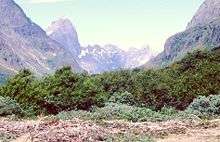Qinngua Valley
_Greenland._Salmon-trout_fishing_in_the_Qinngua_valley_(12168736363).jpg)

Qinngua Valley, also called Qinnquadalen, Kanginsap Qinngua, and Paradisdalen, in Greenland is about 15 kilometres (9.3 mi) from the nearest settlement of Tasiusaq, Kujalleq with 90 inhabitants in 2010. The valley is notable for having the only natural forest in Greenland. Qinngua Valley is about 15 kilometres (9.3 mi) long running roughly north to south and terminating at Tasersuag Lake. The lake drains into Tasermiut Fjord.[1] Mountains rise as much as 1,500 metres (4,900 ft) rise on either side of the narrow valley.[2]
Qinngua Valley may have the warmest climate in all of Greenland. The valley is situated about 50 kilometres (31 mi) from the sea and protected from the cold winds coming off the interior glaciers of Greenland. In total, over 300 species of plants grow in the valley. Qinngua valley contains the only natural forest in Greenland—a thicket consisting mainly of downy birch (Betula pubescens) and gray-leaf willow (Salix glauca), growing up to 7–8 metres (23–26 ft) tall. Growing sometimes to tree height is the Greenland mountain ash (Sorbus groenlandica), which is usually a shrub.[2] Green alder (Alnus crispa) is also found in the valley.[3]
It is possible that other forests of this type once existed in Greenland but were cleared by early settlers for firewood or building material. The valley was declared a protected natural area in 1930. [3]
Although nearly all of ice-free Greenland has an Arctic tundra climate (ET in the Köppen climate classification), Qinngua valley may have a sub-arctic Dfc climate.[2]
References
- ↑ Google Earth
- 1 2 3 "Qinngua Valley". Wondermondo. Retrieved 2015-01-20.
- 1 2 "The Forest Plantations in the Greenlandic Arboretum". Retrieved 2015-01-20.
Coordinates: 60°17′N 44°30′W / 60.29°N 44.50°W